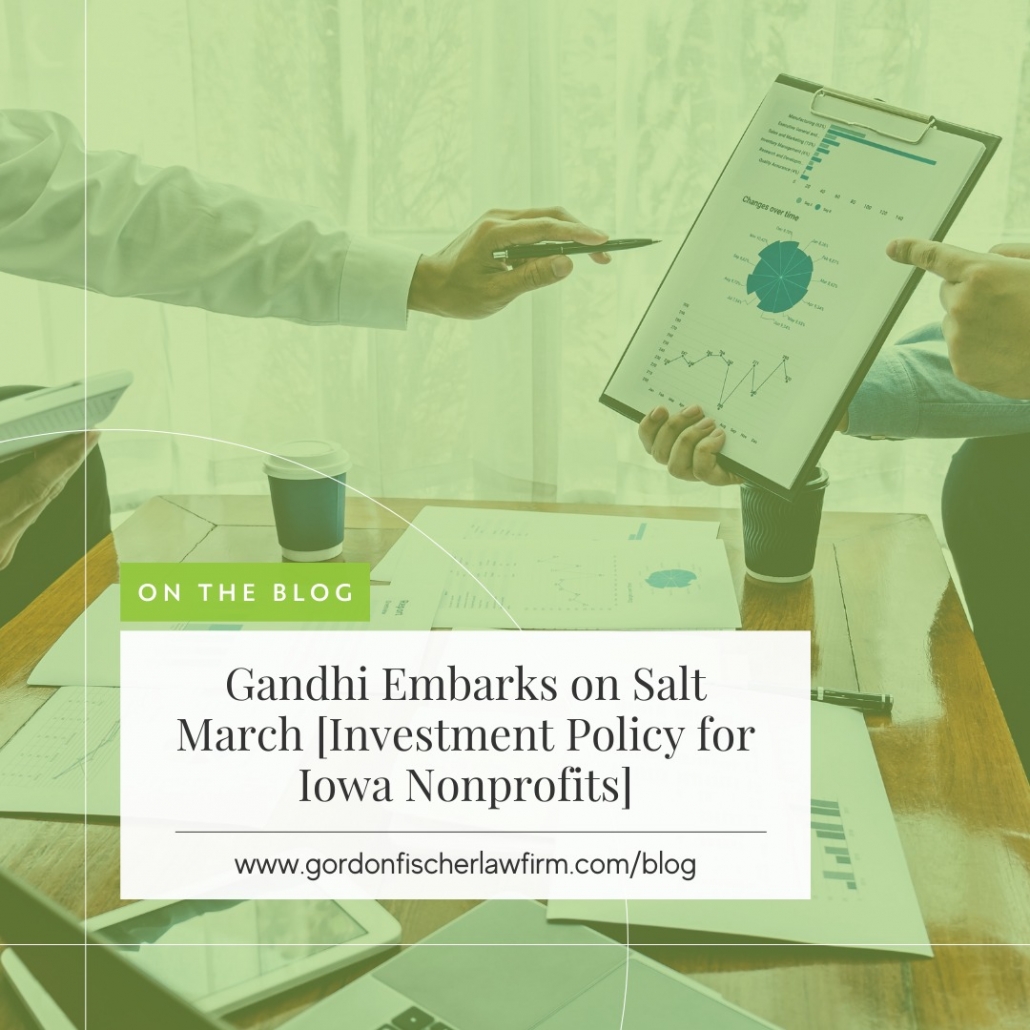March 12, 2025

On this date (March 12) in 1930, Mohandas Gandhi began his 24-day, 240 mile (387 kilometer) “Salt March” to the Indian village of Dandi (then called Navsari) as an act of non-violent civil disobedience to protest the salt tax levied by colonial Britain. Gandhi and his followers walked for 24 days, 10 miles per day. The Salt March helped to galvanize Indian resistance to British rule and introduced the world to Gandhi’s commitment to nonviolence. This all helped to lay the groundwork for India’s independence in 1947.
The Salt March was hard, exhausting, and dangerous.
Your nonprofit needs an Investment Policy. It needs commitment because it too is hard. But surely nothing like the bravery and discipline shown by Gandhi and his followers. So buckle up, read this post, learn about the need for an Investment Policy, and then follow through by contacting me to get started. (My email is gordon@gordonfischerlawfirm.com).
Introduction to an Investment Policy
Does your fave nonprofit have an Investment Policy? Sn Investment Policy is vital for every nonprofit, including yours! It doesn’t take a financial professional to realize that unregulated investing is at best, foolish, and at worst, utterly disastrous.
When we invest in something, we hope that the investment will accrue value over time. In fact, one important way that your organization’s Board of Directors can fulfill its fiduciary responsibility is through investing assets to further the nonprofit’s goals. But investing can be risky. That’s why it’s important that your nonprofit educate and protect itself by establishing an Investment Policy.
What is an Investment Policy?
Investments can be a useful way to grow value and support the mission of a nonprofit organization. But investments don’t always work in an investor’s best interest. In fact, some level of risk is inherent in most investments. An Investment Policy is a set of guidelines or procedures that will help your organization determine and manage how it invests its resources. And, just as importantly, an Investment Policy clarifies why your organization invests its resources the way it does.
An Investment Policy should regulate, at minimum, who is accountable for investment decisions, what kinds of investments are acceptable, and how investments will be tracked.
A comprehensive Investment Policy should accomplish the following:
- Communicate how your organization’s mission and vision will guide investment choices.
- Determine who will be responsible for the various pieces of investment management.
- Communicate clear objectives to all parties involved (Officers, Directors, independent contractors, donors, etc.).
- Clarify the specific procedures for investment selection.
- Confirm procedures related to the expenditure of investments; when and why you’re your organization’s investments be utilized or spent?
- Identify the criteria against which the performance of investments will be measured.
- Address risk (tolerance, management, and diversification).
- Identify reporting and disclosure procedures and requirements.
- Function as a written, objective guide for ongoing oversight of your investments.
Don’t worry, we’ll get into how soon! But first, let’s explore the following question:
Why is an Investment Policy Important?
An Investment Policy protects your organization from poor investment decisions. At that same time, it demonstrates your organization’s adherence to best practices to internal and external parties.
It does this by:
- Providing guidelines for managing an organization’s financial resources effectively.
- Laying out procedures to evaluate and manage risk.
- Ensuring that investment decisions are aligned with the organization’s mission and objectives.
IRS Form 990
A well-written Investment Policy will come in handy when filing IRS Form 990 (the annual nonprofit filing required by the Internal Revenue Service). Form 990 includes several questions about investments and associated policies. These can be found in Part IV, Part VIII, Part X, and Part XI. Organizations must report details about their investment portfolios including the types of investments, the value of each investment, and any gains or losses. A well-defined Investment Policy should create streamlined and reliable processes for tracking investments. This will provide your organization with more accurate data come filing time and will make the filing process less daunting.
Endowment Funds
An Investment Policy is particularly important for organizations with endowed funds. In other words, funds in which the assets are intended to last in perpetuity and are required to support the organization’s programs and services over the long term. An Investment Policy can protect and preserve these critical resources.
Hopefully we’ve convinced you by this point that an Investment Policy is important. Let’s go deeper.
Who Is Responsible?
Who within your organization should be responsible for making investment decisions? How will decisions be reached? Who will be responsible for investment management and tracking? To answer these questions and avoid confusion, your nonprofit’s Investment Policy should clearly define roles and responsibilities. This will ensure consistency and accountability.
Your Fave Nonprofit’s Board of Directors
Your Board of Directors should be responsible for proper management of investments. It’s typically the Board’s job to provide consistent oversight and ensure that funds are being used prudently and effectively. This will include regular audits. The Board should also regularly review the performance of investment accounts. The Investment Policy itself should be reviewed at least quarterly by the Board and updated as needed.
Many nonprofit Boards choose to hire a professional financial advisor or investment manager to implement investments and offer advice. This person’s role can be accounted for in the Investment Policy.
Your Board may choose to appoint the Executive Director (or a similar employee) to actively monitor your organization’s investments day-to-day, and/or to serve as the primary point of contact for outside professional advisors who are assisting in the management of funds.
An Investment Committee may also be useful in order to further define and manage responsibilities.
We’re about to dive into HOW to make smart investment decisions!

How Should Investment Decisions Be Made?
When your organization makes investment decisions, it may wish to consider the following questions:
- What is the purpose of our assets?
- What are the general economic conditions?
- What are the possible effects of inflation or deflation?
- What are the tax consequences, if any, of our investment decisions or strategies?
- What is the role that each investment plays within the overall investment portfolio?
- What is the expected total return from the income and appreciation of investments?
- What are the needs of our organization currently and what are our goals?
- What is an asset’s special relationship or value, if any, to our organization’s purpose(s)?
The specific questions and their answers may vary dramatically based on the size and scope of your organization. But even smaller nonprofits will benefit from creating an investment framework which can grow and develop alongside them.
Goal and Asset Length
How will your Board determine which types of assets to invest in?
It’s especially important for your Board to consider short-, medium-, and long-term goals when investing. Different types of assets require different commitments and hold varying degrees of risk and flexibility.
For example, when your organization decides where and how to invest its money, it will need to consider if it will require quick access to the funds (short-term), if it’s saving up for something in a few years (medium-term), or it it’s investing for the distant future (long-term).
To do this effectively, your Board will need to be well-versed in various types of investments (stocks, bonds, real estate, endowments, etc.). Your Board will need to examine its finances, mission, and goals. It should then utilize that information to determine how best to diversify its funding throughout various types of investments. This is called asset allocation.
As a reminder, if your organization’s Board of Directors does not feel confident in its ability to analyze and distribute investment funds, it can hire a financial expert to consult and assist in this process.
And don’t forget to set goals for how your organization expects and hopes these investments will perform.
By considering these factors and more, your organization can create a streamlined set of processes in its Investment Policy. This will ensure a balanced investment plan that aligns with your organization’s financial objectives.
There’s one more important piece – monitoring and tracking! This will be especially useful when completing your organization’s annual Form 990. Let’s dive in.
How to Track Your Investments (Performance Monitoring, Measurements, and Review)
Are your investments meeting their objectives? It’s important for your nonprofit to regularly review and monitor investment performance. Financial markets and your nonprofit’s circumstances can change over time. This makes it especially important to periodically reassess your organization’s investment strategies. Your organization can then assess progress, adjust as needed, and communicate results to stakeholders.
Regular performance monitoring should involve tracking financial metrics such as return on investment (ROI), portfolio diversification, and risk-adjusted returns. Monitoring processes may also include full audits on a regular schedule. Consider outlining an audit schedule within your Investment Policy. As a reminder, it is your Board’s responsibility to facilitate audits.
Ensure your Investment Policy includes procedures that outline the monitoring, measurement, and review processes that your organization deems necessary to ensure your investments are meeting their objectives. Your Board of Directors is responsible for overseeing these regular reviews.
Conclusion
If your organization is interested in drafting (or revisiting!) its Investment Policy, don’t hesitate to reach out today to the Gordon Fischer Law Firm.
For the month of March, I’m offering a special to Iowa nonprofits. I will draft, revise, and edit, specific to the unique mission of your nonprofit, the ten (10) policies expressly referenced by the IRS on Form 990.
Questions about the ten (10) policies referenced on IRS Form 990?
Again, my email is: gordon@gordonfischerlawfirm.com
Please reach out to me anytime!
####





